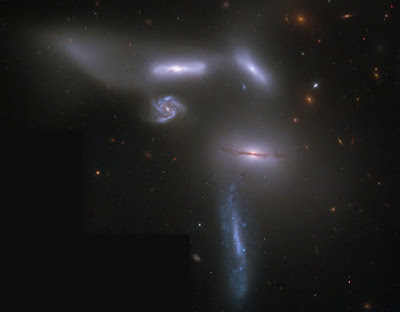I just came upon an excellent blog in the AMIGA group about this paper, and wanted to advertise it!
If I needed to come up with a single sentence to describe this paper, it would be "deconstructing an interaction to understand its physics piece by piece." That sort of paper follows from the NGC5195 blog, but we are now moving to bigger galaxies and more complicated distributions.
Here's the definition.
“By compact group, we mean a small, relatively isolated system of typically four or five galaxies in close proximity to one another." - Paul Hickson, 1997 ARA&A 35, 357
 |
| Seyfert's Sextet (HCG 79). Image Credit: Hubble Legacy Archive, NASA, ESA |
Compact groups are low dispersion and high density. In clusters, the density of galaxies is high, but their velocities relative to one another is also high, so there are few opportunities to collide. Isolated galaxies may have low speeds, but are not dense enough to interact with their neighbors. Compact group environments encourage collisions, which in turn, encourage fast evolution of galaxies from blue star-forming spirals to red, quiescent ellipticals and lenticulars.
 |
| Hickson Compact Group evolutionary cycle shows both the way the group changes as well as the way that the galaxies within the group evolve. Image from Alatalo et al. 2015 |
This rapid evolution of both group and galaxies makes Hickson Compact Groups excellent environments to study galaxy evolution in. In fact, the mid-infrared colors of HCG galaxies are bimodal in a way that other galaxy populations are not. (In a future blog, I will talk more about the mid-IR colors of galaxies). The group I am in has studied this phenomenon, looking specifically at those few HCG galaxies that inhabit those intermediate colors and seeing if there was anything interesting about them. As you may have guessed, there was.
We used the spectrographic prowess of the Spitzer Space Telescope to look at the mid-infrared emission lines. In this case, you look at the molecular H2 lines. These mid-infrared lines require there to be warm or hot hydrogen. The excitation of this line can come from many things, including radiation from stars or an AGN, or shocks. In cases where radiation is the main culprit, the H2 lines will not be the only ones excited. PAH emission will also be excited. So, a simple test exists to figure out whether the excitation is likely from radiation (also the most common mechanism). If the ratio of the H2 luminosity to the PAH luminosity exceeds 4%, then you can be pretty sure that the excitation mechanism is not radiation, leaving it likely that it is due to shocks. Ogle et al 2007 coined these sorts of galaxies "Molecular Hydrogen Emitting Galaxies", or MoHEGs. When Cluver et al 2013 looked at a set of HCG galaxies, and found that the galaxies inhabiting the intermediate mid-IR colors were MoHEGs, meaning that shocks were quite prevalent in these transitioning group galaxies.
 |
| (Left:) HCG57 in optical (g,r,i) with CO(1-0) overlaid. (Right:) HCG57 in infrared (3.6,4.5,8μm) with [C II] overlaid. Adapted from Alatalo et al. 2014 |
 |
| (Left:) The Schmidt-Kennicutt law for different gas regions in HCGs 57a, showing that they, like NGC 1266 are quite far off of the "standard" relation, inefficient. (Right:) A position-velocity diagram of the CO of HCG 57a, separated by regions, showing multiple components, representing different physical states. Adapted from Alatalo et al. 2014 |
But the gas also answers another question for us. It helps us understand what happened in this system. The splash ring, not necessarily noticeable on first-glance at the optical data, says that there was a collision. The smaller, HCG 57d, plowed through HCG 57a a short while ago (think: 10s of millions of years), creating a splash ring that we can see in HCG 57d. The ring is still propagating through HCG 57a, which is why star formation is still suppressed, because the turbulence is still present. And that shock is seen brightly in the other tracers, like the [C II]. Overall, this system is the anatomy of a collision in a compact group. The collision drives a shock, which injects turbulence, and causes the gas to not form stars efficiently, allowing the gas to linger for longer than one would think. Once that shock has completed its propagation through the system, the star formation returns to normal (like in HCG 57d), and we await the next collision in this highly violent environment. Is HCG 57 similar to other systems in this class? We bring you that story in the next paper blog...
The official published version can be found on NASA ADS.
To get a PDF version made by me, you can download it here.
No comments:
Post a Comment